Welcome to Web 2.0
The term “Web 2.0” refers to Web sites that get at least some of their value from the actions of users. Often the concept is compared and contrasted to “Web 1.0,” a retrofitted term describing the construct and limitations under which much of the current Web was constructed, with the concept of home pages, intrusive services such as opt-out marketing and barriers to site content such as registration.
The “old Web” wasn’t all bad, of course. Traditional media organizations and brickand-mortar businesses built sturdy if unspectacular Web sites that didn’t go away with the dot-com boom. They experimented with new ways to reach audiences and customers and many, like e-mail newsletters and Amazon’s customization, still thrive today. These attempts at innovation laid the groundwork for a second round of experimentation that was more open and attempted to harness the power of the user.
“Change starts at the edges. That’s where people—our readers and viewers—probe new practices. That’s also where their emerging culture is forming, a culture in which they look at media from a different perspective,” Francis Pisani1 wrote in the December 2006 issue of Nieman Reports. “And so journalists’ new thinking needs to begin at the periphery, where change comes quickly among the younger generation of users, and a lot more slowly for us. Tomorrow’s potential readers are using the Web in ways we can hardly imagine, and if we want to remain significant for them, we need to understand how. Yet news organizations have been all too slow to notice movement in places that are away from what has been their center.”
Web 2.0 is all about openness, organization and community
It’s all about open—open-source software allowing users control and flexibility, open standards to allow new creation. Web publishers are creating platforms instead of content. Users are creating the content. This is the movement that led Time magazine to declare “You” as the Person of the Year, explaining, “In 2006, the World Wide Web became a tool for bringing together the small contributions of millions of people and making them matter.”
Web publishers are creating platforms instead of content.
Journalists know Wikipedia. Most have seen MySpace, though they might loathe it. They’ve surely seen something hysterical on YouTube, even if it was a Stephen Colbert piece. And eBay is old hat by now. These sites, better than most, illustrate the power of Web 2.0, especially for ordinary Web users. They are powered by one or both of the basic tenets of this new era for the Internet:
- Web sites that are no longer isolated information silos with one-way communication channels (one to many) but rather sources of content and functionality, thus becoming computing platforms serving Web applications to end users. Take MySpace. It succeeds where GeoCities failed because it’s easy for users to post audio and photos, keep a blog and have visitors freely comment on the content to further the flow of communication. The once-popular GeoCities, meanwhile, allowed users to create static home pages for their content with no interactivity or additional functionality.
- An approach of creating and distributing Web content that is characterized by open communication, decentralization of authority, freedom to share and re-use, and the idea of “the market as a conversation” (many to many). In the 1.0 model, a Web publisher (whether a news site or a personal site on GeoCities) would upload content to a Web site for many others to read and the communication transaction would end there. The 2.0 model not only allows those “many others” to comment and add to the content posted by the publisher, but they — the audience — can also add original content themselves.
By designing Web software that uses community input and interaction as its content, sites such as Wikipedia, MySpace, YouTube and Flickr created sophisticated warehouses of content — without creating any content at all. It is still creation, of course, but an upside-down model for creation when compared to the traditional methods anyone over 30 has grown up with.
… sites such as You Tube created sophisticated warehouses of content — without creating any content at all.
Google, meanwhile, changed the economics around advertising without ever hiring a sales rep and powered the business side of the equation for much of Web 2.0.
Let’s take a closer look at each of these phenomena:
Google needs no introduction to journalists thanks to its marvelous search engine. But the company didn’t make money off the millions of daily search queries until it launched AdSense in 2003. With this new program (inspired by an existing company called Overture), Google allowed community members to set the price for ads they could place on the site with a self-service application.
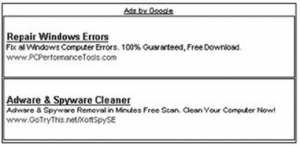
Google ads from Miami Herald Web site home page, Dec. 19, 2006.
An advertiser picks a keyword or search term and tells the system how much it will pay if a Google user clicks on its ads. When a user performs a search with that search term, the advertiser’s ad appears. If the user clicks on it, then Google charges the advertiser.
To extend the scale of pay-per-click advertising, Google created a system so all content publishers could run the Google ads on their sites. So instead of search terms, the Google robots (computer programs that continually “crawl” the Web, indexing the content) scan the text of a content page and display ads that are keyed to match any of the prominent
terms on the page. If a user on an affiliate site clicks on an ad, Google (again) charges the advertiser and then kicks an unspecified percentage to the publisher of that site.
In 2005, Google reported more than $6 billion in advertising revenues (source: http://investor.google.com). One year later, the company broke the $10 billion mark for 2006 ad revenue. All this without hiring a single sales rep.
Journalists also love Google Maps, which is a great example of Web 2.0, because anyone can use the code to create new services based on the maps. For example, journalist/computer programmer Adrian Holovaty took a feed from the Chicago Police Department and combined it with Google Maps to produce the award-winning site chicagocrime.org. Other Web sites have mapped cheapest gas prices, free wireless Internet hot spots, bars and restaurants with happy hours and more (see Google Maps Mania at http://googlemapsmania.blogspot.com/).
This openness contrasts greatly with companies such as Microsoft and AOL that dominated the age of Web 1.0, where everything was proprietary and controlled. Microsoft’s MapPoint, for example, hit the market a few years before Google Maps. But since it was developed without open access (you couldn’t use it without a Windows machine and it wasn’t free), programmers did not rush to build tools with it.
“The Web naturally has a certain grain, and Google is aligned with it,” author Paul Graham2 wrote and was quoted in “The Long Tail” by Chris Anderson. “That’s why their success seems so effortless. They’re sailing with the wind, instead of sitting becalmed praying for a business model, like the print media, or trying to tack upwind by suing their customers, like Microsoft and the record labels.”
In 2006, MySpace became the most popular Web site on the planet in terms of page views. The site claims more than 100 million users (as of September 2006) and served nearly 39 billion page views in November, according to comScore Networks. News Corp. purchased the site in 2005 for $580 million.
By registering and filling out profiles, users create the content. They use “blurbs,” “interests” and “details” sections to present their online persona, and communicate with blogs, photos, video and comments. Teens and twenty-somethings flocked to the site almost immediately. While it gave them an easy way to communicate with one another, it also has drawn criticism as a haven for pedophiles and sexual abusers, creating fear and angst among parents and creating another area for the legal community to monitor. That said, it has also grown into an effective marketing tool for musicians, filmmakers, comedians and small businesses such as bars and nightclubs.
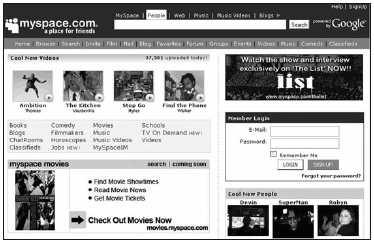
MySpace.com home page.
YouTube was founded by three former employees of PayPal, the online banking and payment firm that powers much of the commerce on eBay. YouTube launched in February 2005 and quickly became one of the most popular sites on the Web, growing faster even than MySpace. Its slogan is “Broadcast Yourself,” which is exactly what millions of people have done, sharing home movies and amateur films with whoever will watch. Plus, video blogging (on-camera commentary) has taken off with the help of YouTube.
The downside for the site is that many people have uploaded other people’s content.
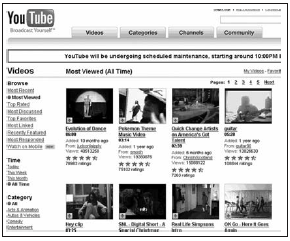
YouTube.com “Most Viewed” videos page.
TV networks claimed copyright infringement, and some of YouTube’s most popular clips have been removed, including a skit called “Lazy Sunday” from “Saturday Night Live.” In June of 2006, however, NBC reversed field and partnered with YouTube to establish an official channel on the site that will display promotional clips from its shows.
With hundreds of thousands of video clips on its site, YouTube’s Web 2.0 structure helps visitors find compelling content quickly. Users can choose from Most Recent, Top Rated, Most Viewed and Most Discussed, which conveniently allows someone to find the next true buzz clip.
In October 2006, Google purchased YouTube for $1.6 billion worth of stock.
Flickr, which launched in February 2004, was developed by Ludicorp, a Vancouver-based company. One year later, Yahoo! bought the photo-sharing Web site but has done little to integrate it into its massive portal.
Flickr is more than a place to share personal photographs. It’s also a community platform that uses tags to power its organization and makes photos of specific topics easy to find. It also has slick functionality for bloggers, who can store photos on the site and display them on their blogs with a few simple clicks.
Tags and folksonomy: New ways to organize content
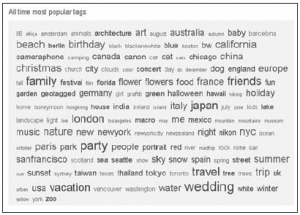
Tag cloud from Flickr.com on Jan. 31, 2007.
Participants in the Web 2.0 revolution use tags to catalog content that they create or just find. Tags are informally chosen and not part of some formally defined classification scheme. This is called a folksonomy and contrasts with a taxonomy since the structure is defined by the users and is constantly changing.
Bloggers use tags that can be traced in search engines like Technorati and Ice Rocket. Photographers use tags to organize photographs on photo sites like Flickr. Web browsers use tags to share appropriate sites with others who have similar interests on del.icio.us. Even Gmail, Google’s e-mail service, allows categorization by tags.
A tag cloud is an automatic way for a Web site to display its tags, giving more prominence to popularity. Computer code generates a tag cloud and displays the more popular tags with a larger font so the audience quickly sees which tag has the most activity or content associated with it.
Can you Digg it?
Web 2.0 loves the wisdom of the crowd and few sites illustrate that better than Digg. Along with the venerable geek site Slashdot and newcomers Reddit and Newsvine, these news sites rely on readers to submit and promote articles from other Web sites.
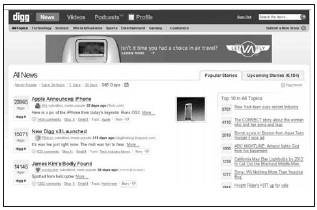
Digg.com’s News page.
So the sites—while widely considered to be news sources (all but Newsvine concentrate on technology)—actually publish no news. Digg users find interesting content elsewhere online, then submit the links and summaries on Digg for consideration, then other Digg users “vote” for stories they like by giving them Diggs. If a story gets enough Diggs, it ends up on the front page of the site.
The Digg effect can be seen on many mainstream news sites that have added a list of the most read, most e-mailed or most printed stories to their Web sites. While they clearly aren’t ready to surrender all news judgment to the crowd, most Web editors recognize there’s power in what others have found interesting on the site instead of solely relying on their more traditional view of what’s news.
What does this mean for journalism?
Readers are no longer passive receivers of our messages. They create, share and comment. And they expect to do it on news Web sites, too.
Jay Rosen, journalism professor at New York University and author of the Press Think blog, has coined the concept of “The People Formerly Known As The Audience.” (To read more about it, Google “TPFKATA.”) This recognition of the fundamental change in how messages are received from mainstream news organizations turns on its head the lesson most of us learned the first day in Communications 101: We send, they receive.
This idea has also come to be known as “news is a conversation, not a lecture.”
It is important to recognize the change in your audience. They want to participate, so help them. Many traditional news organizations include e-mail links on news stories to make it easy for readers to contact the reporter and ask questions or comment on stories. Some have taken the next step and allow readers to comment directly on the story online for all to see.
If you have the opportunity, read the comments posted on your stories and write to those who deserve it. Be proactive in seeking feedback on stories before they are published. It can be as simple as posting a “call to readers” in the newspaper or as advanced as assembling an e-mail list of good targets. For example, if you cover education, build a list of teachers and administrators and send e-mail blasts when you need general comments for a story (more on this later).
Even if you’re not ready to collaborate with your readers on reporting and writing, you can take advantage of Web 2.0 technology. Sites that employ tagging, for example, are useful in reporting on niche topics (del.icio.us chief among them). Use them to organize your searches and to see what other tags related to your beat are popular.
Don’t know where this is heading?
Part of the difficulty for traditional journalists is that we’re not very good at moving forward when we don’t know where we’re going. No one knows how all of this is ultimately going to change what we do or what opportunities this new model presents for us. But the only way we’ll be able to take advantage is if we’re aware of the technologies and actively participate in the changing landscape.
“RSS and tagging are tools I use to track and obtain information in a more timely manner,” said John Cook, a business reporter for the Seattle Post-Intelligencer. “So in that way, they are helpful to me in publishing information quickly online.”
Assignment: Take part in the revolution
To understand fully how Web 2.0 works, you need to use these sites. Open accounts at all of them and test drive the services they offer. Each of these assignments should take you less than a half hour. If you do one per day, you’ll get through all four steps in a week.
- Upload photos and apply tags to them at Flickr.
- Find a handful of Web sites that are interesting to you and tag them on del.icio.us.
- Visit Technorati and browse blog content using tags.
- Visit Digg, Slashdot, Reddit and Newsvine and compare the news stories you find there with your regular news sources.
1. Francis Pisani, “Journalism and Web 2.0,” Nieman Reports, December 2006. Francis Pisani is a freelance blogger and columnist covering information technology and new media in the San Francisco Bay area for several European and Latin American newspapers.
2. Anderson, The Long Tail, page 70. Paul Graham is a popular author and Lisp programmer who wrote “Hackers and Painters: Big Ideas from the Computer Age.”
